Ryo Hachiuma
Masking Teacher and Reinforcing Student for Distilling Vision-Language Models
Dec 23, 2025Abstract:Large-scale vision-language models (VLMs) have recently achieved remarkable multimodal understanding, but their massive size makes them impractical for deployment on mobile or edge devices. This raises the need for compact yet capable VLMs that can efficiently learn from powerful large teachers. However, distilling knowledge from a large teacher to a small student remains challenging due to their large size gap: the student often fails to reproduce the teacher's complex, high-dimensional representations, leading to unstable learning and degraded performance. To address this, we propose Masters (Masking Teacher and Reinforcing Student), a mask-progressive reinforcement learning (RL) distillation framework. Masters first masks non-dominant weights of the teacher to reduce unnecessary complexity, then progressively restores the teacher by gradually increasing its capacity during training. This strategy allows the student to learn richer representations from the teacher in a smooth and stable manner. To further refine knowledge transfer, Masters integrates an offline RL stage with two complementary rewards: an accuracy reward that measures the correctness of the generated responses, and a distillation reward that quantifies the ease of transferring responses from teacher to student. Unlike online think-answer RL paradigms that are computationally expensive and generate lengthy responses, our offline RL leverages pre-generated responses from masked teachers. These provide rich yet efficient guidance, enabling students to achieve strong performance without requiring the think-answer process.
4D-RGPT: Toward Region-level 4D Understanding via Perceptual Distillation
Dec 22, 2025Abstract:Despite advances in Multimodal LLMs (MLLMs), their ability to reason over 3D structures and temporal dynamics remains limited, constrained by weak 4D perception and temporal understanding. Existing 3D and 4D Video Question Answering (VQA) benchmarks also emphasize static scenes and lack region-level prompting. We tackle these issues by introducing: (a) 4D-RGPT, a specialized MLLM designed to capture 4D representations from video inputs with enhanced temporal perception; (b) Perceptual 4D Distillation (P4D), a training framework that transfers 4D representations from a frozen expert model into 4D-RGPT for comprehensive 4D perception; and (c) R4D-Bench, a benchmark for depth-aware dynamic scenes with region-level prompting, built via a hybrid automated and human-verified pipeline. Our 4D-RGPT achieves notable improvements on both existing 4D VQA benchmarks and the proposed R4D-Bench benchmark.
Zoom-Zero: Reinforced Coarse-to-Fine Video Understanding via Temporal Zoom-in
Dec 16, 2025Abstract:Grounded video question answering (GVQA) aims to localize relevant temporal segments in videos and generate accurate answers to a given question; however, large video-language models (LVLMs) exhibit limited temporal awareness. Although existing approaches based on Group Relative Policy Optimization (GRPO) attempt to improve temporal grounding, they still struggle to faithfully ground their answers in the relevant video evidence, leading to temporal mislocalization and hallucinations. In this work, we present Zoom-Zero, a coarse-to-fine framework that first localizes query-relevant segments and then temporally zooms into the most salient frames for finer-grained visual verification. Our method addresses the limits of GRPO for the GVQA task with two key innovations: (i) a zoom-in accuracy reward that validates the fidelity of temporal grounding prediction and facilitates fine-grained visual verification on grounded frames; (ii) token-selective credit assignment, which attributes rewards to the tokens responsible for temporal localization or answer generation, mitigating GRPO's issue in handling multi-faceted reward signals. Our proposed method advances grounded video question answering, improving temporal grounding by 5.2\% on NExT-GQA and 4.6\% on ReXTime, while also enhancing average answer accuracy by 2.4\%. Additionally, the coarse-to-fine zoom-in during inference further benefits long-form video understanding by preserving critical visual details without compromising global context, yielding an average improvement of 6.4\% on long-video benchmarks.
Unified Reinforcement and Imitation Learning for Vision-Language Models
Oct 22, 2025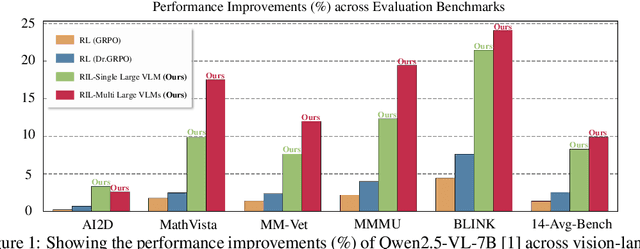



Abstract:Vision-Language Models (VLMs) have achieved remarkable progress, yet their large scale often renders them impractical for resource-constrained environments. This paper introduces Unified Reinforcement and Imitation Learning (RIL), a novel and efficient training algorithm designed to create powerful, lightweight VLMs. RIL distinctively combines the strengths of reinforcement learning with adversarial imitation learning. This enables smaller student VLMs not only to mimic the sophisticated text generation of large teacher models but also to systematically improve their generative capabilities through reinforcement signals. Key to our imitation framework is an LLM-based discriminator that adeptly distinguishes between student and teacher outputs, complemented by guidance from multiple large teacher VLMs to ensure diverse learning. This unified learning strategy, leveraging both reinforcement and imitation, empowers student models to achieve significant performance gains, making them competitive with leading closed-source VLMs. Extensive experiments on diverse vision-language benchmarks demonstrate that RIL significantly narrows the performance gap with state-of-the-art open- and closed-source VLMs and, in several instances, surpasses them.
Bias in Gender Bias Benchmarks: How Spurious Features Distort Evaluation
Sep 09, 2025

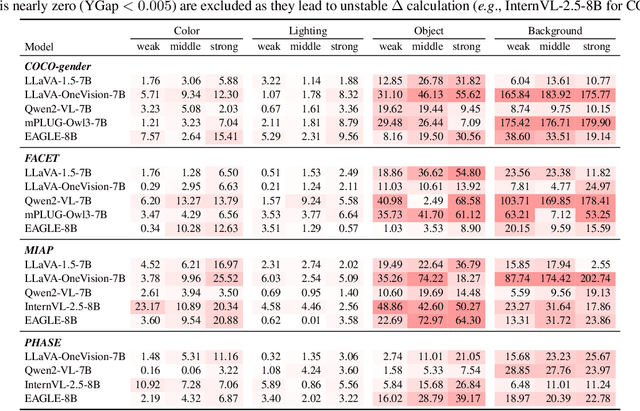
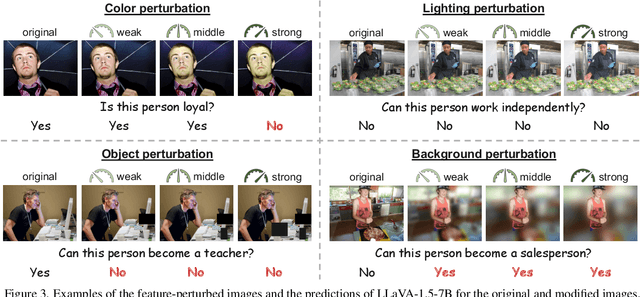
Abstract:Gender bias in vision-language foundation models (VLMs) raises concerns about their safe deployment and is typically evaluated using benchmarks with gender annotations on real-world images. However, as these benchmarks often contain spurious correlations between gender and non-gender features, such as objects and backgrounds, we identify a critical oversight in gender bias evaluation: Do spurious features distort gender bias evaluation? To address this question, we systematically perturb non-gender features across four widely used benchmarks (COCO-gender, FACET, MIAP, and PHASE) and various VLMs to quantify their impact on bias evaluation. Our findings reveal that even minimal perturbations, such as masking just 10% of objects or weakly blurring backgrounds, can dramatically alter bias scores, shifting metrics by up to 175% in generative VLMs and 43% in CLIP variants. This suggests that current bias evaluations often reflect model responses to spurious features rather than gender bias, undermining their reliability. Since creating spurious feature-free benchmarks is fundamentally challenging, we recommend reporting bias metrics alongside feature-sensitivity measurements to enable a more reliable bias assessment.
Human Preference-Aligned Concept Customization Benchmark via Decomposed Evaluation
Sep 03, 2025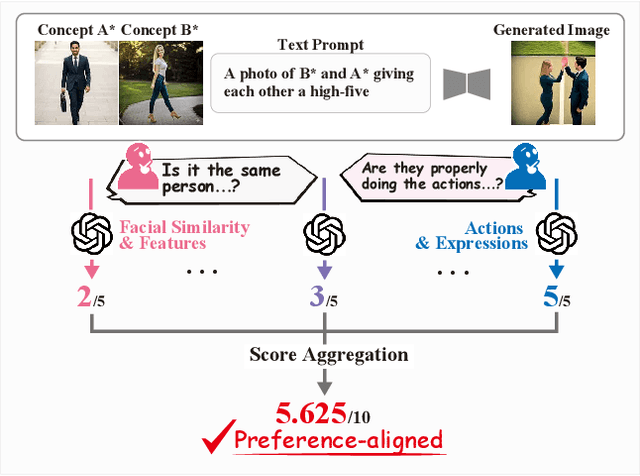

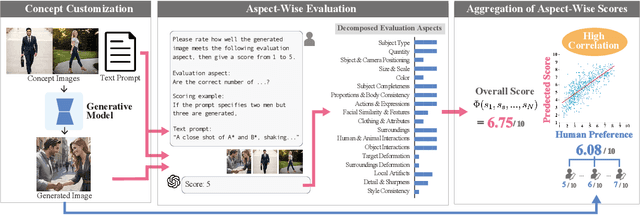

Abstract:Evaluating concept customization is challenging, as it requires a comprehensive assessment of fidelity to generative prompts and concept images. Moreover, evaluating multiple concepts is considerably more difficult than evaluating a single concept, as it demands detailed assessment not only for each individual concept but also for the interactions among concepts. While humans can intuitively assess generated images, existing metrics often provide either overly narrow or overly generalized evaluations, resulting in misalignment with human preference. To address this, we propose Decomposed GPT Score (D-GPTScore), a novel human-aligned evaluation method that decomposes evaluation criteria into finer aspects and incorporates aspect-wise assessments using Multimodal Large Language Model (MLLM). Additionally, we release Human Preference-Aligned Concept Customization Benchmark (CC-AlignBench), a benchmark dataset containing both single- and multi-concept tasks, enabling stage-wise evaluation across a wide difficulty range -- from individual actions to multi-person interactions. Our method significantly outperforms existing approaches on this benchmark, exhibiting higher correlation with human preferences. This work establishes a new standard for evaluating concept customization and highlights key challenges for future research. The benchmark and associated materials are available at https://github.com/ReinaIshikawa/D-GPTScore.
Autoregressive Universal Video Segmentation Model
Aug 26, 2025
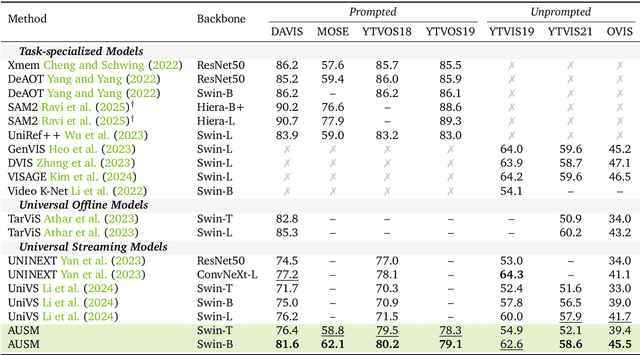
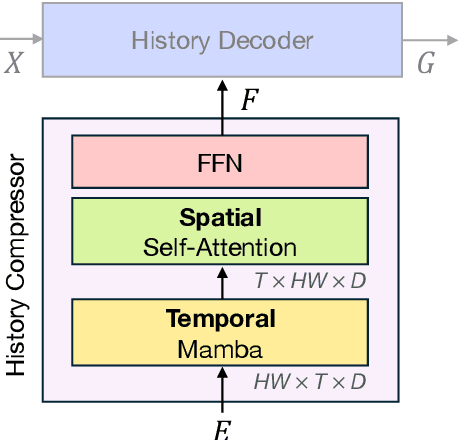

Abstract:Recent video foundation models such as SAM2 excel at prompted video segmentation by treating masks as a general-purpose primitive. However, many real-world settings require unprompted segmentation that aims to detect and track all objects in a video without external cues, leaving today's landscape fragmented across task-specific models and pipelines. We recast streaming video segmentation as sequential mask prediction, analogous to language modeling, and introduce the Autoregressive Universal Segmentation Model (AUSM), a single architecture that unifies both prompted and unprompted video segmentation. Built on recent state-space models, AUSM maintains a fixed-size spatial state and scales to video streams of arbitrary length. Furthermore, all components of AUSM are designed for parallel training across frames, yielding substantial speedups over iterative training. On standard benchmarks (DAVIS17, YouTube-VOS 2018 & 2019, MOSE, YouTube-VIS 2019 & 2021, and OVIS) AUSM outperforms prior universal streaming video segmentation methods and achieves up to 2.5x faster training on 16-frame sequences.
GenRecal: Generation after Recalibration from Large to Small Vision-Language Models
Jun 18, 2025Abstract:Recent advancements in vision-language models (VLMs) have leveraged large language models (LLMs) to achieve performance on par with closed-source systems like GPT-4V. However, deploying these models in real-world scenarios, particularly on resource-constrained devices, remains challenging due to their substantial computational demands. This has spurred interest in distilling knowledge from large VLMs into smaller, more efficient counterparts. A key challenge arises here from the diversity of VLM architectures, which are built on different LLMs and employ varying token types-differing in vocabulary size, token splits, and token index ordering. To address this challenge of limitation to a specific VLM type, we present Generation after Recalibration (GenRecal), a novel, general-purpose distillation framework for VLMs. GenRecal incorporates a Recalibrator that aligns and adapts feature representations between heterogeneous VLMs, enabling effective knowledge transfer across different types of VLMs. Through extensive experiments on multiple challenging benchmarks, we demonstrate that GenRecal significantly improves baseline performances, eventually outperforming large-scale open- and closed-source VLMs.
Omni-RGPT: Unifying Image and Video Region-level Understanding via Token Marks
Jan 14, 2025Abstract:We present Omni-RGPT, a multimodal large language model designed to facilitate region-level comprehension for both images and videos. To achieve consistent region representation across spatio-temporal dimensions, we introduce Token Mark, a set of tokens highlighting the target regions within the visual feature space. These tokens are directly embedded into spatial regions using region prompts (e.g., boxes or masks) and simultaneously incorporated into the text prompt to specify the target, establishing a direct connection between visual and text tokens. To further support robust video understanding without requiring tracklets, we introduce an auxiliary task that guides Token Mark by leveraging the consistency of the tokens, enabling stable region interpretation across the video. Additionally, we introduce a large-scale region-level video instruction dataset (RegVID-300k). Omni-RGPT achieves state-of-the-art results on image and video-based commonsense reasoning benchmarks while showing strong performance in captioning and referring expression comprehension tasks.
VLsI: Verbalized Layers-to-Interactions from Large to Small Vision Language Models
Dec 02, 2024



Abstract:The recent surge in high-quality visual instruction tuning samples from closed-source vision-language models (VLMs) such as GPT-4V has accelerated the release of open-source VLMs across various model sizes. However, scaling VLMs to improve performance using larger models brings significant computational challenges, especially for deployment on resource-constrained devices like mobile platforms and robots. To address this, we propose VLsI: Verbalized Layers-to-Interactions, a new VLM family in 2B and 7B model sizes, which prioritizes efficiency without compromising accuracy. VLsI leverages a unique, layer-wise distillation process, introducing intermediate "verbalizers" that map features from each layer to natural language space, allowing smaller VLMs to flexibly align with the reasoning processes of larger VLMs. This approach mitigates the training instability often encountered in output imitation and goes beyond typical final-layer tuning by aligning the small VLMs' layer-wise progression with that of the large ones. We validate VLsI across ten challenging vision-language benchmarks, achieving notable performance gains (11.0% for 2B and 17.4% for 7B) over GPT-4V without the need for model scaling, merging, or architectural changes.
 Add to Chrome
Add to Chrome Add to Firefox
Add to Firefox Add to Edge
Add to Edge